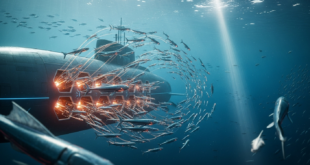Researchers at Penn State Applied Research Laboratory are developing a new system using a technique called supercavitation. Supercavitation is the use of cavitation effects to create a bubble of gas inside a liquid large enough to encompass an object travelling through the liquid, greatly reducing the skin friction drag on the object and enabling achievement of very high speeds.
‘Basically supercavitation is used to significantly reduce drag and increase the speed of bodies in water,’ said Grant M. Skidmore, recent Penn State Ph.D. recipient in aerospace engineering. ‘However, sometimes these bodies can get locked into a pulsating mode.’ ‘Shrinking and expanding is not good,’ said Timothy A. Brungart, senior research associate at ARL and associate professor of acoustics. ‘We looked at the problem on paper first and then experimentally.’ The researchers report the results of their analytic analysis and experimentation online in the International journal of Multiphase Flow. They found that once they had supercavitation with pulsation, they could moderate the air flow and, in some cases, stop pulsation. ‘Supercavitation technology might eventually allow high speed underwater supercavitation transportation,’ said Moeney.
US Navy since long has been interested in high speed hydrofoil craft with an ultimate goal of achieving 100 knots. Researchers at the Naval Postgraduate School (NPS), are working on the development of a joint ultra-high-speed navy vessel (JUHSV), the futuristic vessel anticipated to cruise at a speed of more than 100k, with a capacity to carry nearly 25 sailors.
The 100-knott vessel would be useful for littoral warfare which is required to be fast, agile, well-armed, and able to defend itself. They are either built for a single purpose like anti-surface or Anti-Submarine warfare or multi-role vessels with anti-surface, ship and air abilities are built. It could also be useful in the drug interdiction and capture of Cigarette boats in rough water conditions, a littoral water mine map and sweeping device.
However, there is hydro dynamical 50-knot barrier (about 57 miles per hour), at which the pressure drops at the trailing edge of a spinning propeller, and the water around it boils. When a prop cavitates, it stops generating thrust and starts generating bubbles. The enormous amount of drag created by bubbles attacking a boat’s keel will stop it from accelerating.
NPS Researchers Lay the Foundation for an Ultra-High-Speed Navy Vessel
The Defense Advanced Research Projects Agency (DARPA) awarded NPS Department of Operations Research Associate Professor Dr. Johannes Royset, in partnership with the Massachusetts Institute of Technology (MIT) and Brown University, a $2 million grant to develop the mathematical models that will be utilized in the early design phase of a possible JUHSV.
“Mathematical models are essential for developing a vessel of this type because we simply don’t know how a vessel of this type will behave,” said Royset. “This is so much beyond existing Navy architectural technology that we really need to simulate all different aspects of this ship, not only to simulate, but to make sure our simulations are correct.”
NPS student, U.S. Army Capt. John Sabol, has joined Royset, assisting with the modeling and simulation for his NPS degree thesis. “We’re looking at how we can use existing mathematical equations and relationships to try and [limit] uncertainty in the most extreme cases,” said Sabol. “It’s a way to analyze the data we’re collecting and estimate what the worst case could be even though we haven’t seen it.”
Sabol said, “We’re hoping that the results of our work can be extended well beyond the joint ultra-high-speed vessel although this is a very interesting and relevant application of the work. If we can prove these methodologies are relevant and useful to the joint high-speed vessel, it would be great to show how they could be relevant to other projects in the future as well.”
“The Marines and the Navy, Army included, have foreseen a need to operate at high speeds in littoral waters,” said Sabol. “Enhancing our expeditionary capabilities is pretty important to us.”
Design and Assessment of a Super-High Speed, Hybrid Hydrofoil/SWATH Crew Boat
Few hydrofoil vessels have been built to reach speeds of higher than 60 knots. “One of the most successful designs is made by Boeing, called Jetfoil, which used fully submerged foils. This design required complex control mechanisms with very fast reaction times at speeds in excess of 80 knots. These types of hydrofoil crafts switch to displacement mode when encountering heavy weather.
Under contract with the US Navy, Boeing built FRESH-1. A two phase program was planned with a Boeing canard configuration designed for 80 knots for Phase 1, and Grumman designed a transiting set of foils for Phase 2 with the objective of demonstrating 100 knots.
The difficulty of stabilization for these high speeds was demonstrated when FRESH-1had an accident during the Phase 1 trials. Although the AGEH was designed for an initial speed of 50 knots, it had the capability to take additional power and different foils to achieve a much higher speed.
Concept Design for Wavecutter
Vasileios Georgiadis, Kyle Miller, and Leon Faison, Innovative Ship Design Lab, Massachusetts Institute of Technology presented a concept design for a high-speed vehicle called Wavecutter to expeditiously transfer personnel from shore to oil platforms exists within the offshore oil industry.
“In order to provide better operability in a wider range of weather conditions and proper payload efficiency with very-high speed to station, innovative hull designs and features have been considered. The new design would need to incorporate features that provide both good seakeeping characteristics along with the ability to travel at high speeds.”
Wavecutter is a hybrid design that would combine the advantages of a SWATH design with those of surface-piercing (SP), super-cavitating (SC) hydrofoils. In high sea states, the vessel travels at lower speeds in displacement mode, taking advantage of the seakeeping characteristics of the SWATH design. At lower sea states, the vessel will travel in excess of 80 knots in foil borne mode, taking advantage of the high lift to drag ratio of the hydrofoils.
 International Defense Security & Technology Your trusted Source for News, Research and Analysis
International Defense Security & Technology Your trusted Source for News, Research and Analysis


